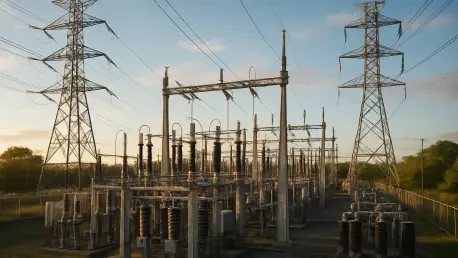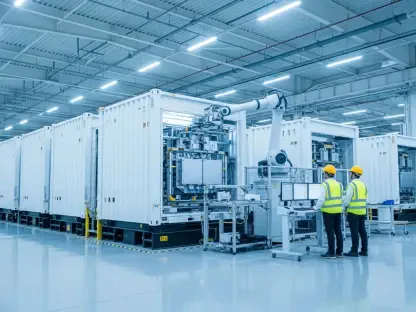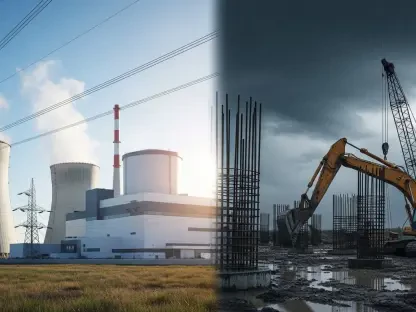What if the key to a cleaner, more reliable energy grid was already within reach, buried in the infrastructure of one of America’s largest power networks? PJM Interconnection, serving 13 states and Washington, D.C., faces skyrocketing energy demands from data centers and electrification. Yet, a staggering opportunity lies dormant: surplus capacity at existing facilities could potentially support 153 gigawatts (GW) of solar, wind, and storage. This hidden potential might just be the lifeline needed to avert a looming energy crisis while slashing carbon emissions.
The significance of this possibility cannot be overstated. With PJM recording a peak load of 160 GW during a recent heat wave, and projections pointing to even greater demand in the coming years, the region stands at a crossroads. Building traditional gas-fired plants takes up to seven years, a timeline that risks grid instability and soaring costs for millions of consumers. Harnessing surplus capacity for renewables, which can be deployed in as little as two years, offers a faster, greener path forward. This exploration delves into how untapped grid connections could reshape energy planning and meet urgent needs.
Uncovering a Hidden Energy Goldmine
Deep within PJM’s sprawling network, an often-overlooked resource waits to be tapped. Surplus interconnection capacity—unused access points at existing thermal and renewable facilities—represents a chance to integrate massive amounts of clean energy without the delays of new infrastructure. Researchers have identified this as a critical solution at a time when energy demand is surging, driven by tech giants and the push for electrification across industries.
This capacity isn’t just a theoretical concept; it’s a practical asset hiding in plain sight. Many thermal power plants operate at a mere 15% capacity factor, leaving room for significant new projects to connect to the grid. Similarly, existing solar and wind sites have untapped potential that could be paired with storage to maximize output. Leveraging these resources could bypass the bottlenecks of traditional grid expansion, offering a shortcut to a more sustainable energy mix.
The Growing Pressure on PJM’s Grid
PJM Interconnection, as the nation’s largest regional grid operator, faces unprecedented challenges. Data centers alone are projected to drive demand spikes that could outpace supply within the next few years, while electrification of transportation and heating adds further strain. The stakes are high: failure to meet these needs risks blackouts, economic disruption, and derailed climate goals.
Compounding the issue is the slow pace of conventional solutions. New gas plants, while reliable, require nearly a decade of planning and construction, a luxury the region cannot afford. Meanwhile, consumer energy costs loom as a persistent concern, with delays in capacity threatening price spikes. Finding a rapid, scalable alternative is no longer optional—it’s imperative for grid stability and public trust.
Decoding the 153 GW Opportunity
A recent study from UC Berkeley lays out a transformative vision: PJM’s surplus interconnection capacity could support up to 153 GW of clean energy. At thermal power plants, 52 GW of unused capacity could enable 74 GW of solar and 5 GW of wind by the end of the decade. Existing renewable sites, with capacity factors of just 19% for solar and 16% for wind, offer another 25 GW of potential waiting to be unlocked.
Storage plays a pivotal role in this equation. By integrating 23 GW of 6-hour battery storage at renewable locations, capacity factors could soar to 75%, paving the way for an additional 28 GW of solar and 25 GW of wind. Yet, economic hurdles, such as the loss of clean energy tax credits under current policies, trim the feasible total to 106 GW. These figures paint a picture of immense promise tempered by real-world constraints that must be addressed.
The implications of these numbers are profound. If fully realized, this capacity could cover a significant portion of PJM’s future demand, reducing reliance on fossil fuels and accelerating decarbonization. However, turning potential into power requires navigating regulatory and financial barriers, a challenge that demands innovative thinking and swift action from all stakeholders.
Expert Insights and Industry Momentum
Voices from academia and industry alike highlight the urgency and opportunity of this approach. Lead researchers Umed Paliwal and Amol Phadke from UC Berkeley emphasize the speed advantage: “Solar and storage projects can be operational in roughly two years, a fraction of the time needed for gas plants, meeting PJM’s immediate needs.” Their analysis frames surplus capacity as a critical stopgap in a rapidly tightening energy landscape.
On the industry front, David Mindham of EDP Renewables North America offers a practical perspective. “Since reforms to the Surplus Interconnection Service process, multiple requests have been submitted, and gigawatts of new storage capacity are expected to connect soon,” he notes. This real-world momentum signals growing confidence in surplus capacity as a viable bridge to long-term grid solutions, blending research insights with actionable progress.
The convergence of these viewpoints underscores a broader consensus: surplus capacity isn’t just a theory but a tangible asset. While optimism abounds, both researchers and industry leaders point to the need for streamlined policies to eliminate delays. Their combined input adds depth to the argument that rapid deployment of renewables is not only possible but essential.
Strategies to Turn Potential into Power
Transforming 153 GW of potential into actual clean energy requires concrete steps. Standardizing Surplus Interconnection Service agreements across PJM’s region could cut through bureaucratic red tape, enabling developers to move faster. A unified framework would minimize confusion and accelerate project timelines, ensuring capacity isn’t left idle.
Another critical measure involves extending interconnection rights for retired generators beyond the current one-year limit. Preserving these access points for new renewable projects prevents valuable grid connections from being lost. Additionally, creating a capacity “heat map” to visually pinpoint available interconnection spots would help prioritize development efforts, directing resources where they’re needed most.
Finally, enhancing valuation methods for hybrid resources like solar-plus-storage is essential. Current systems often undervalue their contributions to grid reliability, limiting their integration into capacity markets. By refining these assessments and aligning with PJM’s reformed interconnection processes, approved by federal regulators earlier this year, the path to scalable clean energy becomes clearer. These strategies collectively form a roadmap for immediate impact.
Reflecting on a Path Forward
Looking back, the exploration of PJM’s surplus capacity revealed a remarkable opportunity to bolster the grid with 153 GW of clean energy, even as economic realities pared that down to 106 GW. The urgency of rising demand, coupled with the slow pace of traditional power solutions, framed this capacity as a vital lifeline. Expert voices and industry actions echoed a shared belief in the power of rapid renewable deployment.
What emerged most clearly was the need for systemic change to unlock this potential. Standardized processes, extended rights, and better tools for identifying capacity stood out as actionable fixes that could bridge the gap between promise and reality. These measures offered hope that grid stability and sustainability could coexist.
As the energy sector moved forward, the focus shifted to collaboration among policymakers, grid operators, and developers to refine interconnection frameworks. Overcoming economic barriers and prioritizing hybrid resources became the next frontier. This journey, sparked by untapped capacity, pointed toward a future where clean energy could meet demand without delay, setting a precedent for grids nationwide.









